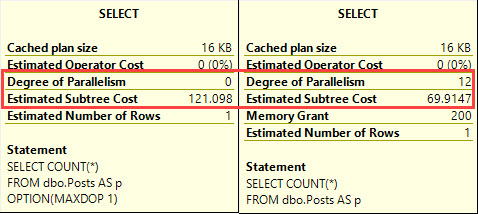I have a pivot query that uses a parallel plan even though the cost is less than 5.
The Cost Threshold for Parallelism is set to default of 5, and MAXDOP is 0.
SELECT Column1, Column2 Column3, Column4 AS Column5, Column6 Column7, Column8 Column9, Column10 Column11
FROM (
SELECT Column12,
Column13,
Column1
FROM Database1.Schema1.Object1
) Object2 PIVOT( SUM(Column13) FOR Column12 IN (Column2, Column4, Column6, Column8, Column10) ) AS pvtScore;
Following screenshot shows the estimated subtree cost as 1.39.
I am wondering why the parallel plan was used when the cost threshold is at 5 for parallelism to kick in.
Version: SQL Server 2008 R2




6.72.